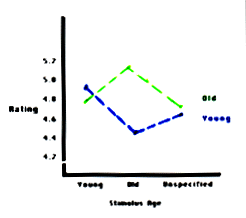
The concept of ageism was examined between younger and older men and women in the present study.
Subjects consisted of 86 older men and 90 older women
recruited from area senior citizen centers, and 90
younger men and 90 younger women recruited from
undergraduate psychology classes. Subjects completed a variety of measures examining age and sex-role attitudes. Each subject
completed the measures rating a single stimulus
person: either a 25-year-old male, female, or adult; a
70-year-old male, female, or adult; or women, men, or
people in general.
Overall, the present study confirmed that older adults
are perceived more negatively than younger adults.
A significant age by gender interaction effect was
found. Both younger and older men rated stimulus older
adults significantly less positively than stimulus younger
adults. However, older women rated stimulus older adults
significantly more positively than they rated other
stimulus-age groups. Older women were the only subject
group that did not exhibit a consistent negative bias against older
adults. Conversely, younger women rated stimulus older
adults more negatively than any subject group.
American society has been described as maintaining a stereotypic and often negative perception of older adults (Busse, 1968). This negative and/or stereotypic perception of aging and aged individuals is readily apparent in such areas as language, media, and humor and has been termed "ageism" (Butler, 1969).
The purpose of the present study was to further examine the concept of ageism correcting for some of the methodological problems outlined elsewhere in this document. Younger and older individuals were asked to complete the Attitudes Toward the Aged semantic differential scale (Rosencranz & McNevin, 1969), the rating of an autobiographical sketch, a Sex-Role Stereotype Questionnaire (Rosenkrantz, Vogel, Bee, Broverman, & Broverman, 1968), and a Revised Facts on Aging Quiz (Miller & Dodder, 1980). Each individual was asked to complete the above items for a single stimulus person: either a 25 year-old male, a 25 year-old female, a 25 year-old person, a 70 year-old male, a 70 year-old female, and a 70 year-old person, women in-general, men in-general, or people in-general. In addition, all individuals were were asked to complete a demographic sheet which included an item regarding what the subject considers to be the best and worst years of a person's life.
Younger subjects were recruited from psychology courses at a major Midwestern university. Most studies of ageism have excluded older adults from participation as subjects. This is ironic as this is the population most effected by this form of bias or stereotype. Therefore, older adults were also included as participants in this research. In previous studies which have included older adults as subjects, they have been primarily non-well institutionalized older adults. The present study included well, community-dwelling older adults recruited from a variety of senior social programs located within a four county region of a major Midwestern city.
This design served several functions. First, multiple measures were used to operationally define and examine ageism and it incorporates a between-subjects design strategy. This design was selected to minimize the possibility of the within-subjects design bias described by Kogan (1979), and to test for convergence between the measures listed. In addition, both younger and older adults, were used as subjects in this study. Thus, the study not only examined the perceptions of each age group towards older adults but tested for the existence of age differences.
The above design also addressed two theoretical issues concerning ageism. First, the design included an examination of the relationship of ageism to another "sm", specifically sexism and also tested for potential gender differences between older and younger, men and women. Subjects were classified according to gender as well as age on stimulus items. In other words, men and women of both age groups were asked to rate stimulus items consisting of men, women, or nonspecified gender for age groups consisting of young, old, or age unspecified. Therefore, the interactions of age and gender as well as ageism and sexism were examined.
An initial multivariate analysis of variance was computed with age of the subject (age), gender of the subject (gender), age of the stimulus person (stimulus-age), and gender of the stimulus person (stimulus-gender) as the independent variables. Dependent variables were education, health rating, life-satisfaction rating, mean rating of the autobiographical sketch, mean ratings for the three subscales of the Attitudes Towards the Aged semantic differential, mean ratings for the two subscales of the Sex-Role Stereotype Questionnaire, and the percentage of correct responses on the Revised Facts on Aging Questionnaire. As significant effects were found for age of subject on education, health rating, and life-satisfaction, a multivariate analysis of covariance was performed using these variables as covariates. Older adults had significantly fewer completed years of education, rated their health status lower, and rated their life-satisfaction higher than younger adults. It should be noted that no other main effects or interaction effects were found for education, health rating, or life-satisfaction.
Overall, the present study confirmed that older adults are perceived more negatively than younger adults. Older men and women were rated significantly lower on the personal acceptability-unacceptability and the instrumental-ineffectual subscales of the Attitudes towards the Aged semantic differential, and they were also rated lower on the male-valued item subscale of the Sex-Role Stereotype Questionnaire. The results are not entirely consistent, however, as no difference was found between ratings of younger and older adults on the autobiographical sketch.
The results can be discussed further in one of two ways. First, the ratings of older, younger, and age-unspecified adults can be examined in greater detail. Second, the effect of subject variables (age and gender) on the perception of younger and older adults can be examined. Each of these will be discussed below.
Older adults were rated significantly lower by younger adults on the subscale of personal acceptability-unacceptability. Older adults did not demonstrate this bias. The personal acceptability-unacceptability scale is designed to assess characteristics that are relevant to the functioning of an individual within a social milieu (Rosencranz & McNevin, 1969). Thus, individuals who rate low on this dimension would be seen as less acceptable to others. For example, older adults in the present study were rated significantly closer to the negative pole on six items as compared to younger adults. Those six negative pole items were uncooperative, inflexible, unpleasant, dejected, sad, and dull. Therefore, older adults were viewed by younger adults overall as being more unacceptable with six items being specifically responsible for this difference (See Figure 1). This finding is somewhat deceptive as a gender and age of subject interaction was found and will be discussed below.

| Figure 1: | Personal Acceptability-Unacceptability Scale as a Function of Stimulus Age and Subject1s Age |
Older adults were also rated significantly lower than younger adults on the subscale of instrumental-ineffective. The scale is described by Rosencrantz and McNevin (1969) as being relevant to an individual1s adaptability and competency. Older adults were rated by all individuals as being lower on every item comprising this subscale. Therefore, older adults were consistently perceived as being less adaptable and competent than younger adults (See Figure 2). An interaction for age and gender of subject was also found on this dimension and well be presented below. However, regardless of the interaction, all subject groups rated older adults lower on this subscale. It should be noted that this scale has the most consistent factor pattern on the computer factor analysis that was performed as part of this study.
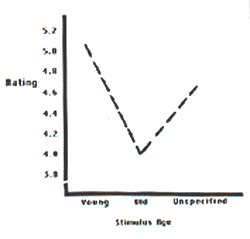
| Figure 2: | Instrumental-Ineffective Scale as a Function of Stimulus Age |
The present study also demonstrated that older adults were rated significantly lower on the male-valued items scale of the Sex-Role Stereotype Questionnaire. Thus, in a sense, older adults were rated as less masculine (with these being considered positive traits) or more feminine (with these being considered negative traits) on this scale than younger adults (See Figure 3). For example, older adults were rated near the feminine pole of "not at all self-confident" and "almost never acts as a leader". It is important to note however, that this effect only occurred for items whose feminine pole is rated negative. Both of the items listed above are considered socially undesirable (Rosenkranz et. al., 1968). For female-valued traits, older adults were not rated more positively than younger adults. Therefore, older adults were rated as becoming more feminine/less masculine, with feminine being defined as socially undesirable. It should be added that the Sex-Role Stereotype Questionnaire places masculine and feminine on a single dimension as polar opposites. However, this may not be accurate; masculinity and femininity may be separate dimensions, unidimensional concepts, or exhibit a linear relationship.
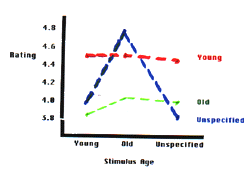
| Figure 3: | Male-Valued Items Scale as a Function of Stimulus Age and Stimulus Gender |
While the above data demonstrate a bias against older adults, this bias was not found for the autonomous-dependent subscale or the autobiographical sketch. Several factors may play a role in this discrepancy. First, ageism may not a a unidimensional construct; older adults may simply be rated as lower on one dimension and not another. Also, there may be a problem with the autonomous-dependent subscale. This subscale exhibited no consistent factor pattern in the computed factor analysis. Finally, individuals may rate a person differently if they are unfamiliar with the person or are describing a group of individuals as opposed to rating a specific person for whom they know details of that person1s life. Thus, ratings of classes of people may be very different than ratings of specific people.
It should be noted that for all of the above effects, age-unspecified individuals were rated higher than older adults but lower than younger adults.
The interaction of age and gender had a significant impact on the perception of younger and older adults. Few differences were found for the age and gender of the subject rating younger adults. In other words, stimulus younger adults were rated similarly by men and women, both young and old. However, there was a significant age and gender interaction in the ratings of older adults. The ratings of younger and older men paralleled one another. They both rated older adults significantly lower on the instrumental-ineffective scale, for example. Older and younger women differed dramatically, however. Older women rated older adults significantly higher than any other stimulus-age group. They are the only subject group that did not exhibit a consistent bias against older adults. Conversely, younger women rated older adults the lowest of any subject group. In other words, the most significant difference in stimulus ratings occurred between ratings of younger and ratings of older adults by young women subjects (See Figure 4 and Figure 5).
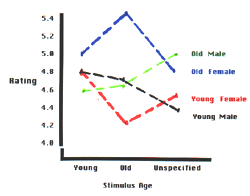
| Figure 4: | Personal Acceptability-Unacceptability as a Function of Stimulus Age, Subject1s Age, andSubject1s Gender |
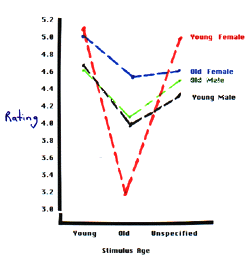
| Figure 5: | Instrumental-Ineffective Scale as a Function of Stimulus Age, Subject1s Age, & Subject1s Gender |
Demographic data were obtained on the General Information Sheet. These data were obtained to examine the relationship between these variables and perceptions of older adults. Education, health ratings, and life satisfaction ratings had no significant effect on the ratings of older or younger adults. While there were significant differences between older and younger subjects on these variables, these differences did not impact the ratings of the stimulus persons. This statement can be made for two reasons. First, the correlations between these demographic variables and the attitude measures were not significant. Second, the demographic variables were treated as covariates. Thus, the effects of the variables on the attitude measures would have been removed in the data analyses.
It is important to note that knowledge about aging and the aged, as measured by the Revised Facts on Aging Quiz (Miller & Dodder, 1980), had no apparent impact on subjects' attitudes toward older adults. In other words, subjects what rated an older adult less positively did not have a higher percentage of incorrect answers on the Quiz or know less about aging and the aged. Also, no significant difference was found for age or gender of the subject. The data demonstrated that regardless of age, most individuals had a number of misconceptions about aging or the aged.
Subject's perception of the best and worst years of a person's life provided little additional support for a negative bias against aging and the aged. Approximately, 31 percent of the subjects selected the seventies as the worst years of a person's life. However, over 50 percent of the subjects selected the teens as the worst years of a person's life. The major difference between the two subject age groups on this item was the range of ages selected. Older adults selected ages all across the life-span as the worst years, whereas younger adults selected ages primarily at the ends of the life-span. Additionally, many older adults provided an explanation for their response. For example, on older man selected the seventies as the worst years as many older adults do not have health insurance during those years and this is very stressful. Younger adults provided no explanations for their answers.
Several factors need to be considered when evaluating the results of this study. First, it is a cross-sectional design. Thus, differences between ages can not be construed to be a function of age. For example, it would be erroneous to conclude that older women become more positive about older adults as they age. The differences between the groups may be due to a generational or cohort effect. This particular group of older women may have always felt more positively about older adults including when they were themselves younger women.
An additional limitation of the study was that older adults were recruited from senior social programs. These individuals may not be representative of all community-dwelling older adults.
Another problem with the present study was that no clear information was obtained concerning socioeconomic status or income. Many older adults refused to answer these items. Thus, there was a large percentage of missing data with regard to occupation (current or prior) or income. Therefore, these variables was excluded from the data analyses.
The present study does not answer conclusively the question of whether ageism exists. Rather, it provides evidence that a bias exists against older adults on at least some dimensions. It also provides evidence that one1s gender and age may interact to play a role in one1s perception of older adults. This needs to be studied more fully. In addition, further work needs to be conducted on the perception of older adults as individuals. The autobiographical sketch suggests that older adults perceived as individuals may not experience a negative bias because of age. This may have implications for the increasingly age segregated society within which we live. This phenomenon needs to be researched further. It is also hypothesized that older adults are perceived as becoming more "feminine" with age, with 'feminine' being associated with socially undesirable traits or behaviors.
As with any "ism", ageism may impact one's self-esteem and limit human potential. Older adults are a valuable resource in our society, both economically and socially. If, in fact, our culture maintains an ageist bias, then this resource is being wasted. More research needs to be conducted on the existence of ageism, its cause, context, and underlying dimensions, and effects.
Acknowledgements: Thanks to the American Psychological Association Science Directorate for their support with a Dissertation Research Award.
Bibliography upon request
Feel free to drop me a line with any questions or comments you may have. Thanks.

